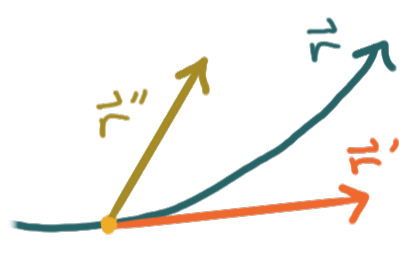Limits and derivatives and integrals of vector valued functions are defined component wise:
A vector-valued function \(\bm{r}\) is continuous at a point at \(t = c\) if \(\lim_{t \to c} \bm{r}(t) = \bm{r}(c),\) and is continuous on its domain if it’s continuous at every point in its domain. A vector-valued function is smooth if the derivatives of its component functions exist for all orders. A curve itself is smooth if it has a smooth parameterization. A parameterization \(\bm{r}(t)\) of a curve is regular if \(\bm{r}'(t) \neq \bm{0}\) for any \(t\) — the parameterization never stops along the curve. Analogously, a parameterization \(\bm{r}(s,t)\) of a surface is regular if \(\frac{\partial \bm{r}}{\partial s}\) and \(\frac{\partial \bm{r}}{\partial t}\) are not parallel (not linearly dependent) at any point.
 For a curve \(C\) with parameterization \(\bm{r}\)
that represents the position of a particle along that curve in space,
the derivative \(\bm{r}'(t)\) represents the velocity vector \(\bm{v}(t)\) of the particle,
and likewise \(\bm{r}''(t)\) represents its acceleration vector \(\bm{\alpha}(t).\)
The line with parameterization \(\bm{r}(t_0) + \bm{r}'(t_0)t\)
will be tangent to the curve \(C\) at the point \(\bm{r}(t_0).\)
A different parameterization of \(C\) will have velocity and acceleration vectors
with the same direction at the same point, but different magnitudes.
For a curve \(C\) with parameterization \(\bm{r}\)
that represents the position of a particle along that curve in space,
the derivative \(\bm{r}'(t)\) represents the velocity vector \(\bm{v}(t)\) of the particle,
and likewise \(\bm{r}''(t)\) represents its acceleration vector \(\bm{\alpha}(t).\)
The line with parameterization \(\bm{r}(t_0) + \bm{r}'(t_0)t\)
will be tangent to the curve \(C\) at the point \(\bm{r}(t_0).\)
A different parameterization of \(C\) will have velocity and acceleration vectors
with the same direction at the same point, but different magnitudes.
For a smooth curve \(C\) with parameterization \(\bm{r}\) the arclength of \(C\) between \(t=a\) and \(t=b\) is calculated by the integral \({\int_a^b |\bm{r}'(t)| \,\mathrm{d}t\,.}\) For a curve \(C\) with parameterization \(\bm{r},\) its arclength parameterization is \(\bm{r}(s),\) where \(s\) is its arclength “function” defined as \(s = \int_0^{t} |\bm{r}'(\mathtt{t})| \,\mathrm{d}\mathtt{t}.\) The arclength parameterization has the property that the point corresponding to a specific value of \(t\) lies at a length of \(t\) along the curve from the “anchor point” where \(t = 0.\)